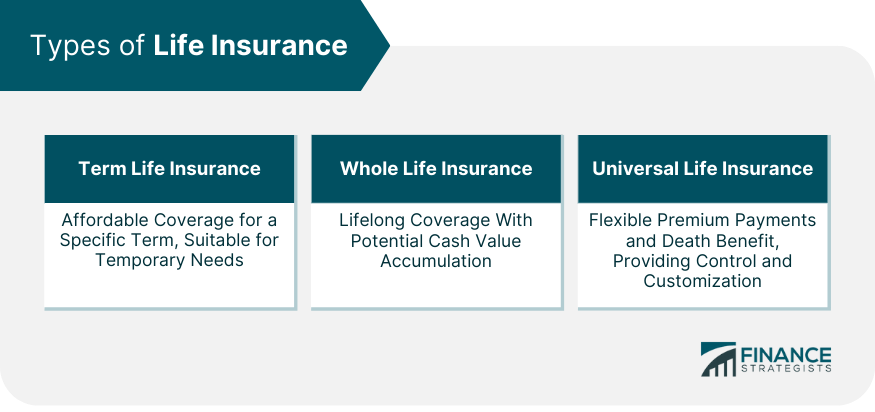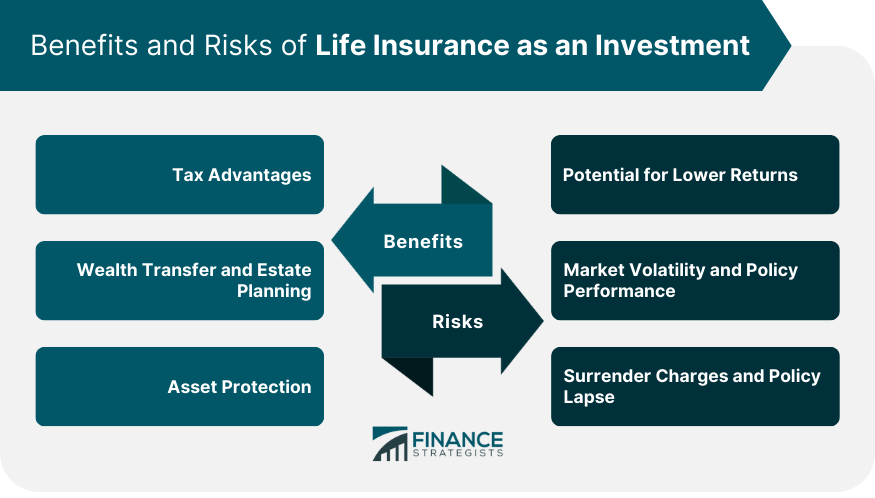Life insurance is a financial tool that provides protection and financial security to individuals and their loved ones. It serves as a contract between the policyholder and the insurance company, where the insurer promises to pay a designated amount, known as the death benefit, to the beneficiaries upon the policyholder's death. This benefit is typically tax-free and can be used by beneficiaries to cover living expenses, pay off debts, or maintain their standard of living. In the event of the policyholder's untimely death, life insurance ensures that beneficiaries are financially protected and supported. It offers peace of mind to individuals, knowing that their loved ones will be taken care of and have a secure financial future, even in their absence. Life insurance can also be viewed as an investment, as certain types of policies include a savings or investment component. These policies, such as whole life insurance or universal life insurance, offer a cash value component that grows over time. Part of the premiums paid goes towards the cost of insurance, while the remainder is allocated to the cash value account, which earns interest or dividends based on the insurance company's performance. The cash value of a life insurance policy can be accessed by the policyholder during their lifetime. Policyholders can withdraw funds, take out policy loans, or even surrender the policy for its cash value. This flexibility allows individuals to use life insurance as a potential source of savings or to supplement their retirement income. However, it's important to note that accessing the cash value may have implications on the death benefit and can affect the policy's long-term performance. Term life insurance is the simplest and most affordable type of life insurance. It provides coverage for a specific term, such as 10, 20, or 30 years. If the policyholder dies during the term, the death benefit is paid to the beneficiaries. However, if the policyholder outlives the term, the coverage expires, and there is no payout. Term life insurance is ideal for individuals seeking temporary coverage to protect their loved ones during specific periods, such as when they have young children or outstanding debts. Whole life insurance is a permanent form of life insurance that provides coverage for the entire lifetime of the insured, as long as premiums are paid. It offers a death benefit to beneficiaries upon the insured's death, but it also includes a cash value component that accumulates over time. The cash value grows tax-deferred and can be accessed through policy loans or withdrawals. Whole life insurance is often chosen by individuals who want lifelong coverage and the potential for cash value accumulation. Universal life insurance is another form of permanent life insurance that offers flexibility in premium payments and death benefit amounts. It combines the features of term life insurance with a cash value component. Policyholders can adjust their premium payments and use the accumulated cash value to cover premiums or increase the death benefit. Universal life insurance provides more control and customization options compared to other types of life insurance policies. One of the significant advantages of life insurance as an investment is its potential tax benefits. The death benefit received by beneficiaries is typically tax-free, providing financial support without the burden of income taxes. Additionally, the cash value accumulation within permanent life insurance policies grows on a tax-deferred basis. This means that policyholders can accumulate wealth within the policy without incurring immediate tax liabilities, allowing the cash value to grow more efficiently over time. Life insurance is an effective tool for wealth transfer and estate planning. By naming beneficiaries, policyholders can ensure that their loved ones receive financial support even after they are gone. Life insurance proceeds generally bypass probate, allowing beneficiaries to access the funds more quickly. This can be particularly beneficial for individuals with significant assets or complex estate planning needs. It can help provide liquidity to pay estate taxes, protect the value of an estate, and facilitate the smooth transfer of wealth from one generation to the next. In some jurisdictions, life insurance policies offer asset protection benefits. The cash value of a life insurance policy is often shielded from creditors and lawsuits, providing an additional layer of protection for policyholders' assets. This can be particularly valuable for individuals in professions or situations where the risk of legal actions or financial liabilities is higher. By placing funds within a life insurance policy, individuals can safeguard their savings from potential legal claims or creditors. While life insurance policies with a cash value component can offer some growth potential, the returns may be lower compared to other investment options available in the market. The focus of life insurance is primarily on providing protection and financial security rather than generating high investment returns. Individuals seeking higher growth potential may need to consider alternative investment vehicles to complement their life insurance coverage. The performance of a life insurance policy's cash value component may be influenced by market conditions and the insurance company's investment performance. If the company's investments underperform or if the policy is tied to market indexes, the cash value growth may be lower than expected. Policyholders should carefully review the policy provisions and understand how market conditions can impact the policy's performance. Life insurance policies often have surrender charges, especially in the early years of the policy. If a policyholder decides to surrender the policy or withdraw funds, these charges can significantly reduce the cash value received. Additionally, if premiums are not paid as scheduled, the policy may lapse, resulting in a loss of coverage and potential forfeiture of accumulated cash value. It's important for individuals to carefully review the policy terms, understand the surrender charges, and ensure that the policy remains in force by paying premiums on time. When considering life insurance as an investment, individuals should evaluate their financial goals and risk tolerance. Life insurance is primarily designed for protection, and the investment component is a secondary consideration. Individuals seeking higher investment returns may need to explore other investment options that align better with their risk tolerance and long-term financial goals. Individuals should consider factors such as the policy's cash value growth potential, fees and expenses, surrender charges, and flexibility in premium payments and death benefit amounts. It's essential to work with a trusted insurance professional who can guide individuals through the selection process and help identify policies that align with their investment objectives. Life insurance policies, especially those with a cash value component, can come with higher premiums compared to term life insurance. Individuals need to assess their budget and determine if they can comfortably afford the premiums associated with their desired coverage. It's important to strike a balance between the desired coverage and affordability to ensure that the policy remains in force and provides the intended benefits. Life insurance serves as a crucial component of wealth management, offering protection and financial security to individuals and their loved ones. It can also be viewed as an investment tool, particularly with policies that include a cash value component. While life insurance offers potential tax advantages, wealth transfer benefits, and asset protection. Individuals need to carefully consider their financial goals, risk tolerance, and policy features. Life insurance as an investment may not offer the same growth potential as other investment options, and individuals should evaluate their long-term objectives and consider complementary investment strategies. By aligning life insurance coverage with financial objectives and working with trusted professionals, individuals can leverage life insurance as an effective tool for wealth management and protection.What Is Life Insurance?
How Life Insurance as an Investment Works
Types of Life Insurance
Term Life Insurance
Whole Life Insurance
Universal Life Insurance

Benefits of Life Insurance as an Investment
Tax Advantages
Wealth Transfer and Estate Planning
Asset Protection
Risks of Life Insurance as an Investment
Potential for Lower Returns
Market Volatility and Policy Performance
Surrender Charges and Policy Lapse

Things to Consider When Using Life Insurance as an Investment
Financial Goals and Risk Tolerance
Policy Selection and Features
Cost Considerations
Conclusion
Life Insurance as an Investment FAQs
Yes, certain types of life insurance policies, such as whole life insurance or universal life insurance, have a cash value component that can accumulate over time. This can be viewed as an investment within the policy.
Life insurance offers potential tax advantages, including tax-free death benefits for beneficiaries and tax-deferred growth of the cash value component within permanent life insurance policies.
Risks include the potential for lower investment returns compared to other options, policy performance tied to market conditions, and surrender charges if the policy is surrendered or lapses.
Consider factors such as cash value growth potential, fees and expenses, surrender charges, and flexibility in premium payments and death benefit amounts. Consulting with an insurance professional is recommended.
Life insurance with a cash value component can potentially be used as a retirement savings tool, allowing individuals to access the accumulated cash value during their lifetime. However, it's important to consider other retirement savings options to ensure adequate funds for retirement.
True Tamplin is a published author, public speaker, CEO of UpDigital, and founder of Finance Strategists.
True is a Certified Educator in Personal Finance (CEPF®), author of The Handy Financial Ratios Guide, a member of the Society for Advancing Business Editing and Writing, contributes to his financial education site, Finance Strategists, and has spoken to various financial communities such as the CFA Institute, as well as university students like his Alma mater, Biola University, where he received a bachelor of science in business and data analytics.
To learn more about True, visit his personal website or view his author profiles on Amazon, Nasdaq and Forbes.











